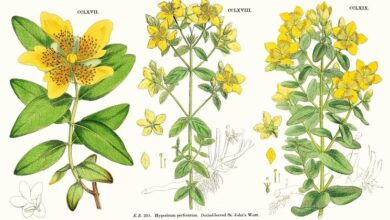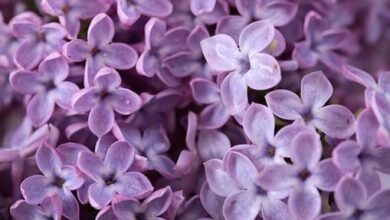White mustard (Sinapis alba)

The white mustard is a plant that is important and interesting uses in the kitchen. But, would you like to know how to take care of it so that you can benefit from it in a healthy way? If you have answered yes, then I will also tell you what its characteristics are.
In this way, you will know how to identify it, in addition to what are those basic care that you must provide for it to be healthy.
Origin
White mustard, whose scientific name is Sinapis alba, is an annual herb also known by the name of yellow mustard. It is native to the Mediterranean region and reaches a height of up to 75cm.
Characteristics of white mustard

It has an erect and branched habit, with basal leaves 5 to 15 cm long by 2-6 cm wide, lobed, with a toothed margin; its upper leaves are lobed and serpentine-toothed.
The flowers are grouped in clusters of up to 30cm. They are about 10mm in diameter, and are yellow. The fruit contains 1 to 4 seeds, brownish-brown in color and rounded.
Another characteristic of this plant is that it bears fruits with elongated spikes and a hard lower part, in addition to having the characteristic smell of mustard that we know. Commonly, some people tend to confuse it with Synapsis arvensis, a similar species but with different fruits.
This type of plant bears fruits annually, where you can recognize it by its erect and branched grass, which is between 30 and 80 cm in size, where its stem is rough, without glands and reflex hairs.
In addition, the leaves of the white mustard are alternate of broad lower ones and with petioles at the end of these. Its flowers grow in clusters, are light yellow, have four divergent sepals of 4 to 5 mm and four petals of 8 to 10 mm in length.
As for its fruit, it is dry, opens spontaneously and has a length of 20 to 45 mm, generally hard at the bottom and with a flattened, ensiform bill.
What are their cares?
If you want to have a copy, we recommend you provide the following care:
-
The first thing to keep in mind is that it is not a plant that is usually pruned.
-
The watering of white mustard should not be flooded since it does not resist it, but it does withstand a certain time of drought, so it is best to wait until it has 3 cm of dry soil depth to water it again.
-
In the field, you have to wait until the plant has at least 4 leaves for watering, but you can also wait for it to rain only.
-
Watering should be done 3 to 4 times a week in the summer and every 4 to 5 days the rest of the year.
-
For the white mustard fertilizer it is recommended to use organic fertilizers that have phosphorus and potassium, and that have less nitrogen.
-
Subscribing has to be done from the beginning of spring with ecological fertilizers, once a month and until the end of summer.
If you use this plant to feed animals, the best thing is that it is not when it is in bloom, since at that stage it is toxic for them. It is recommended that it be consumed with a great difference in time to the flowering period
To grow white mustard it must be done in full sun, outdoors, so that it can flower and bear fruit. However, this can be done in a pot or in the garden, as long as it has good drainage for planting.
To sow new plantations, you have to sow their seeds in a seedbed tray and once they are 10 to 15 cm high, transplant them to individual pots or your garden.
Planting tips
The Sinapis alba is a plant having international crop and commonly grown in temperate zones, this feel the most widely used commercially. And for its cultivation, three characteristics or fundamental requirements are needed, which are:
-
The land to grow white mustard has to be clay, sandy and somewhat dry.
-
The seeds of the plant must be sown in rows that are about 25 cm apart.
-
The fertilizer to be used has to be one that does not contain nitrogen, so the use of manure is not recommended.
Complying with the above, white mustard in a cold season would only take about 30 days for its leaves to have the characteristic flavor of this, and therefore could be cut.
In four weeks the yellow flowers will appear, their stems will have seeds and special care must be taken with these, since they are usually very fragile and break easily, so it will be better to cut them while they are still green.
White mustard seeds have a viability of 7 years, provided they are kept in a dark, cool and dry place, something that contributes a lot to future plantings that you want to carry out.
Pests

White mustard plantations can be affected by many pests, which can greatly damage the beginning of the crop or when it is about to flower. Cabbage moths are found in this type of pest, one of the most destructive in the world, since it feeds on the flowers, leaves and shoots of the plant in question.
Another of the pests that affect white mustard is the defoliating vaquita, which can affect crops occasionally, and which can affect the plantation both its larvae and its adult specimens, thus causing the loss of leaf area.
In addition, aphids also tend to affect white mustard plantations, although it is more frequent in black mustard crops because it is more susceptible. Aphids can reproduce rapidly, causing extensive damage to white mustard crops and may appear on them during vegetative growth.
Applications
Apart from being used as an ornament, its main use is culinary. In fact, the seeds are used whole to flavor pickles and vinaigrettes, or toast. The seeds of white mustard are also used whole as ingredients in marinades and to make pickles.
An important aspect to highlight about this plant is that everything that is superficially seen in it is edible, which is why it has a great attraction for the culinary arts.
In general, thanks to its mild and delicate flavor, it is used to mix different herbs and spices from the kitchen. In addition, its leaves are used to make delicious soups and salads that delight all the diners who try them.
Another exquisite use is with vegetables, where it is necessary to boil them for at least half an hour in salty water, drain them and present them with chopped onions, some dressings and olive oil, salt and lemon. That will give these foods a spectacular flavor.
Contraindications

Like all plants that have chemical compounds, white mustard has contraindications, since an excess consumption of it can affect a person’s body, causing illness or disease.
In the case of women, they can be affected if they consume the leaves, seeds, flowers of white mustard during their pregnancy, since the glucosinolate content can cause an abortion or damage the baby’s thyroid, causing the glands in the future thyroid is not working properly.
You should avoid using white mustard directly as an external remedy in those who have dermal hypersensitivity, as well as avoid using it in areas that are irritated, bruised, on the face, that are blistered or that suffer from psoriasis.
Another contraindication that this plant has is its use when there are ulcers on the skin or with symptoms of dermatitis, since it could cause considerable burns to the skin.
If you suffer from gastritis, dyspepsia and digestive ulcers, you should not consume white mustard, since its composition will irritate your stomach and stimulate its functions.
Similarly, those who suffer from circulatory and vascular problems, who suffer from kidney colic, cystitis or other urinary tract infections, should avoid prolonged consumption of this plant, as well as those derived from it.




